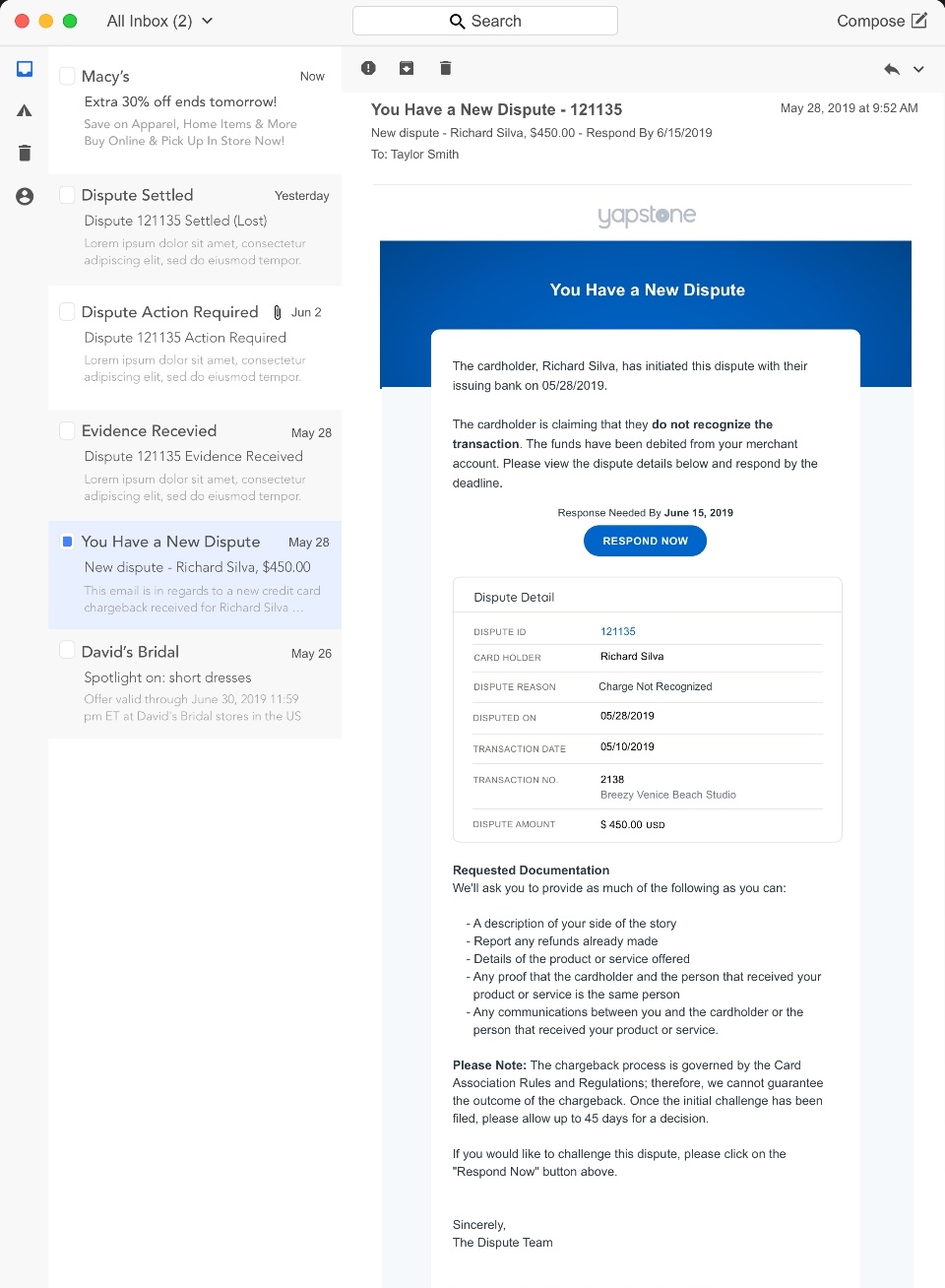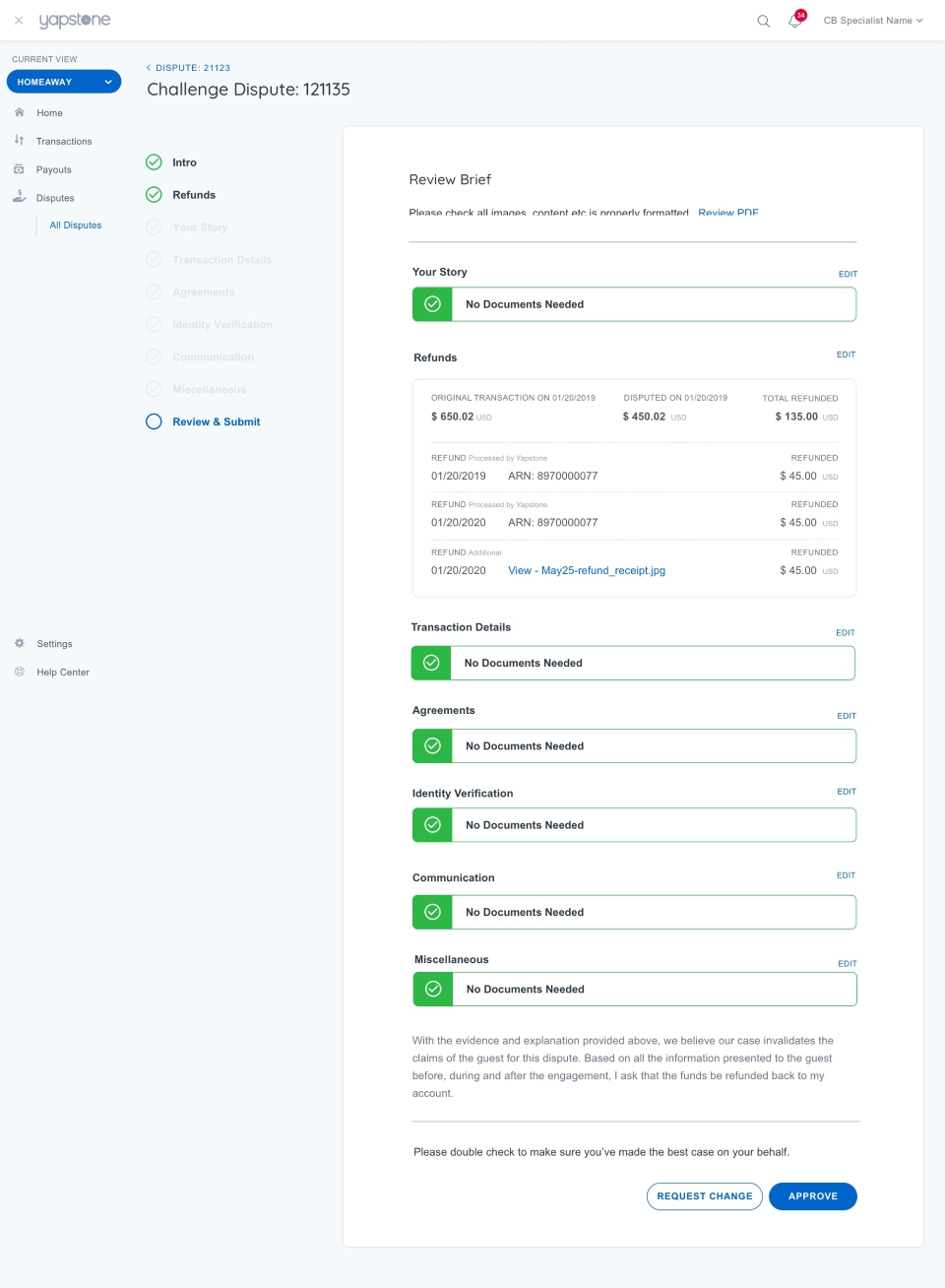Yapstone Dispute Center Case Study
Turning a $10M Support Problem into a Self-Serve Win for Landlords

Project Snapshot
Yapstone (via Philosophie)
Financial Technology
March 2018 - January 2019
Product Manager, UX Research Lead, Frontend Developer
React, Node.js, ZenDesk API
Product Management, UX Research, Frontend Development, FinTech Strategy
Summary: I led the design and delivery of Dispute Center, a self-serve tool that helped landlords respond to credit card chargebacks by crafting strong, evidence-backed rebuttal letters that cut support costs while improving win rates.
The Problem
If the hot tub was broken, guests would sometimes dispute the entire rental fee (thousands of dollars!) through their credit card provider. These disputes (called chargebacks) were frequent, high-stakes, and incredibly messy.
Yapstone's support team was manually building rebuttal letters for landlords. The process was slow, expensive, and rarely successful. It was also bleeding money: Yapstone was spending roughly $10 million a year managing this operational burden on behalf of partners like VRBO and Booking.com.
Who was affected
Vacation rental landlords, property managers, and Yapstone's support team.
Why it mattered
Manual chargeback responses were costing millions while delivering poor outcomes for landlords.
Context & Constraints
Yapstone was a massive payments processor flying under the radar, powering transactions for vacation rental sites. They brought in my team at Philosophie to tackle this specific mess: reduce chargeback support costs and empower landlords to fight their own battles.
But we weren't working with a clean slate:
- We were outside consultants, constantly negotiating for access to Yapstone's internal tech and data
- We had to work around existing systems like Zendesk, where most support tickets lived
- Integration support was limited, so we had to be scrappy
Let's just say: getting things done required a lot of creativity, persistence, and persuasion.
My Role & Team
As Product Manager, UX Researcher, and Frontend Developer:
- I led discovery research with customers and internal teams
- I managed stakeholder alignment and presented research reports
- I designed the product experience and iterated with live feedback
- I wrote production code and supported QA
Team Collaboration
I collaborated closely with Yapstone's Head of Design and a small cross-functional team: a design director, product designer, and up to three engineers.
Solution Approach
The Product
We built Dispute Center, a standalone web app that walked landlords through the rebuttal letter process step-by-step. Think TurboTax, but for fighting chargebacks.
It helped landlords:
- Understand the dispute they were facing
- Identify and gather relevant evidence (photos, receipts, correspondence)
- Generate a clear, compelling rebuttal letter
- Submit everything seamlessly into Yapstone's Zendesk-based support workflow
The system was easy to use and built to mirror the internal process Yapstone's support agents used (only cleaner and faster).


Discovery Process
- Interviewed over 15 landlords and property managers to uncover patterns behind disputes
- Conducted internal interviews with Yapstone's support staff to understand pain points and workflows
- Compiled findings into a research report to guide product direction
- Did some undercover competitive research by talking to other vendors in the space
Technical Implementation
- Built with React + GraphQL for a modern, responsive experience
- Integrated directly with Zendesk to automate downstream support processes
- Designed flows to reduce friction and increase clarity for non-technical users
Outcome & Impact
Estimated Annual Savings
vs Days Response Time
User Interviews
- Internal support agents were freed up for more complex issues
- While our consulting engagement ended at delivery, the feedback internally was that this product was a game-changer for Yapstone's partners
Lessons Learned
Biggest Takeaway
As an outside PM with no formal power, your influence depends entirely on execution speed, clarity of thinking, and strength of evidence.
We delivered all three, but navigating internal politics still required finesse.
What I Learned
- Identify influencers and decision-makers early
- Map internal political terrain as part of my research
- Design timelines and presentations that aligned with how my client actually worked... not just how I wished they would
What I Carry Forward
This project fundamentally changed how I think about running discovery research that's as much about people and politics as it is about users.
Now, before any project kicks off, I always spend time understanding internal dynamics, clarifying stakeholder incentives, and designing a path that avoids landmines and unblocks decision-making early.
Let's Talk Fintech, Ops Automation, or High-ROI Internal Tools
I love turning operational pain into efficient, delightful products. If you're in fintech or any business drowning in manual processes, let's fix that.